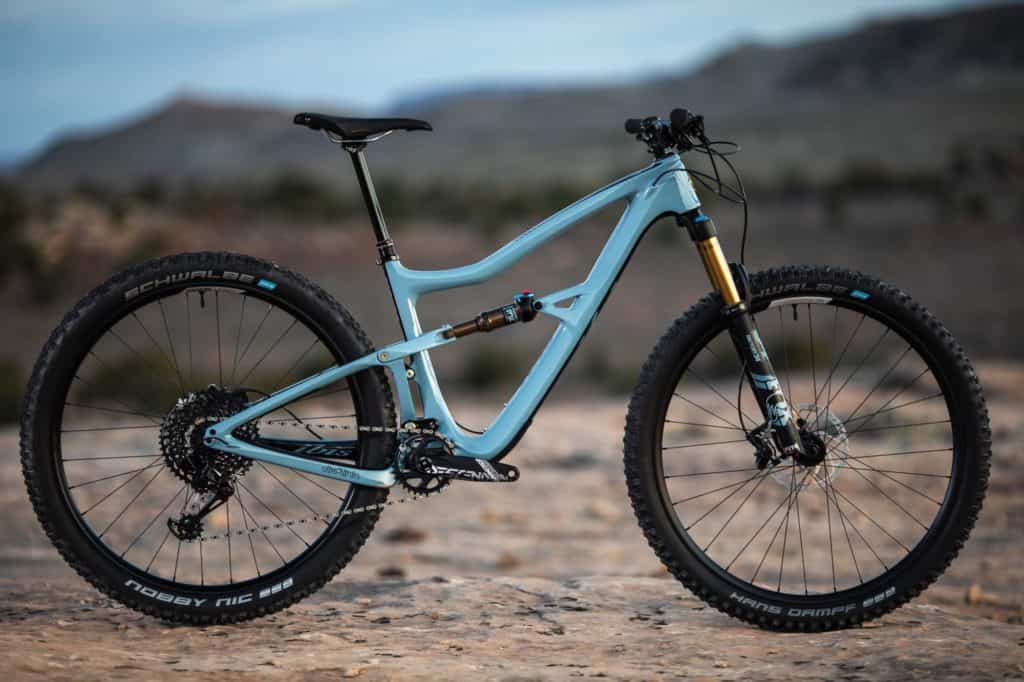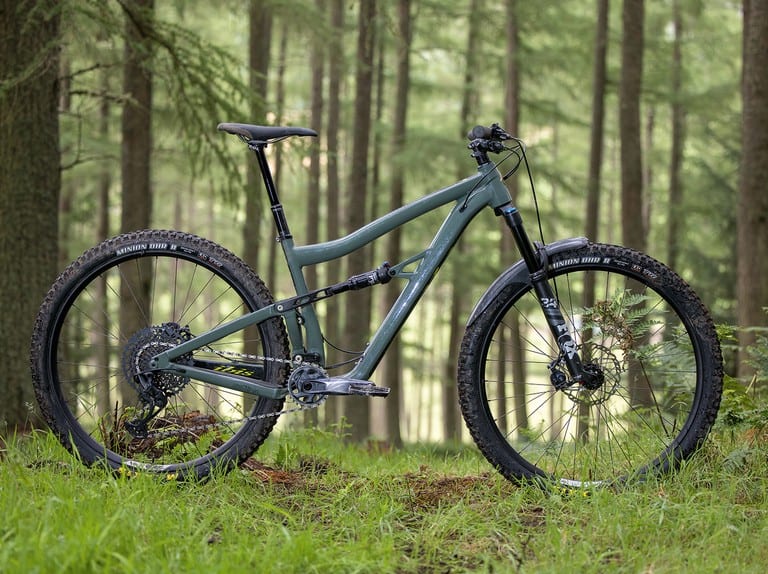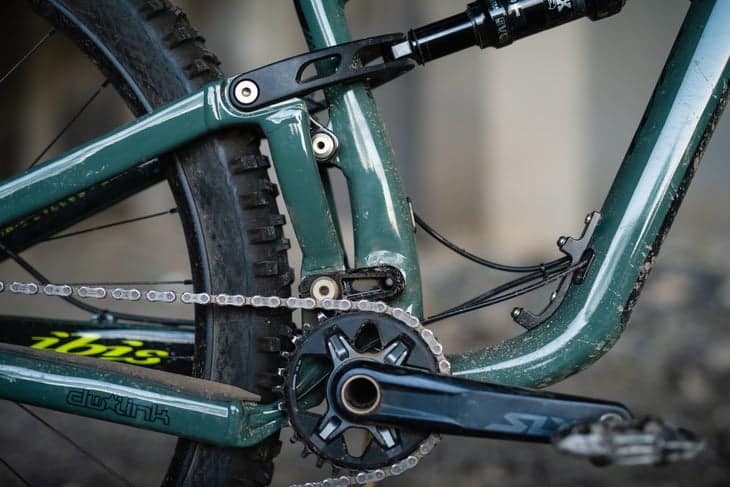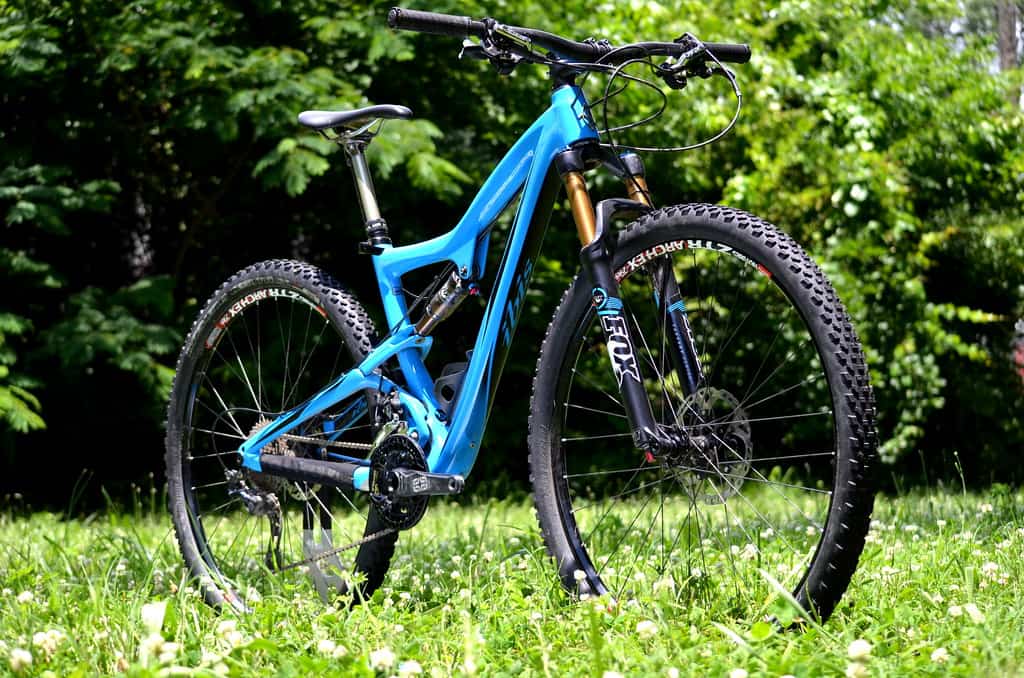You are probably interested in purchasing an Ibis Ripley, the V4, or the AF and wonder if it is worth your money, right?
You are in the right place. We have covered 50+ mountain bikes and collaborated with MTB lovers to bring the most detailed take on the Ibis Ripley.
From their frame, climbing, and descending ability to other important details, we’ll tell you all about it.
A Detailed Review Of The Ibis Ripley V4
Specs
- Front Travel: 120-140 mm
- Rear Travel: 120 mm
- Frame Material: Carbon Fiber Monocoque
- Frame Size: S, M, L, XL.
- MTB Type: Trail/Cross Country
The Ripley 4 is responsive, playful, and exciting to ride any day!
Some riders consider the V4 a trail bike due to its 120-140mm travel. The XC scene is expanding, and now a bike with 100-120 mm of travel qualifies to be a Cross Country MTB. Therefore, a V4 with 120mm of travel front is an XC bike. But what makes the Ripley V4 a great MTB?
Frame & Geometry

The Ripley V4’s pride is the Carbon fiber monocoque frame, making it a lighter weight than the Ripley AF. You’ll get the same frame quality, regardless of which V4 you take. The frame also has a bottle cage mount, a downtube protector, and rubber swing arm protectors.
The Ibis engineers also tested and applied an ideal geometry to fit XC and trail. Though unnoticeable to riders that haven’t tried earlier models, the V4 received some critical changes to the geometry. The DW-Link bike also feels more stable than the V3 on the trail.
The modern slack and long geometry in the V4 is the first thing that struck my eye. With a 475 mm reach, 76-degree seat angle, and 66.5-degree head angle, the V4 couldn’t get better. The V4 also takes forks with 44mm of offset.
The geometry may be informative, but it might not describe the bike’s character and nature. The geometry of the V4 is more felt than reading on a piece of paper. The MTB plummets down the trails like no one’s business. However, how does it perform on technical climbs?
Climbing
The Ripley V4 is a trailblazer and the perfect bike when pedaling and climbing. Its efficiency is unmatched, and even the DW link suspension performance is something to behold. No squats when the trail suddenly turns steep.
I pedaled the bike on a long climb and felt relaxed after that. The Ripley has a minor bump sensitivity that improves the pedaling platform, unlike other bikes.
The rocketship, paired with light XC or trail tires, will roll to the top without the rider breaking a sweat. If you are looking for a trail/XC bike to smoke out your trail riding buddies, the V4 should be your weapon of choice.
This ultra-efficient climber feels more forgiving and more active than the V3. The bike is super responsive when seated and climbing and doesn’t feel tense to jump forward with the front wheel on the slightest provocation on the pedal. The DW link offers terrific traction on the rear to keep the tire on the ground to utilize your input.

Descending
Downhills are as enjoyable as climbing, and the Ripley V4 is reputable on both grounds. It seems to punch above the competition, especially on technical terrains. It maintains agility wherever you want it to be. It’s also lightweight and rolls over bigger obstacles like rocks and rough terrain and rocks the bike parks.
The Ripley is super capable, but if you want to tackle descents faster, your best bet would be to go for a longer travel, the 140mm! The handling of the V4 is lively, and the quiver killer responds to every input from the rider, from negotiating corners to jumping over obstacles.
The V4 has shorter stays than its enduro sister, the Ripmo. The bike still handles well, and the steering is calmer. The 120 mm rear travel might be an issue for some riders when riding downhill. Some wish it could have a longer travel on the rear, but as an XC bike, the 120 mm is more than enough.
Ride Impressions
Trail and XC bikes perform well on flats, and the V4 conquers both scenes, thanks to its steeper seat tube angles. I paid attention to how the Ripley rolls and bounces on flat and technical terrain, and I was more than impressed.
The Ripley also felts more progressive than the enduro counterpart, Ibis’s Ripmo. I consider the Ripley V4 one of the best of its class and well-rounded.
An aggressive rider or a heavy rider will still enjoy riding the Fourth-generation Ripley with the 120mm of rear travel. You’ll only be uncomfortable riding on extremely technical terrain suitable for 150mm of travel bikes.
Therefore, the bike is more suitable for more groomed flow trails and ideal for mountain bikers who value efficiency and speed.
In-Depth Ibis Ripley AF Review
Specs
- Front Travel: 130 mm
- Rear Travel: 120 mm
- Frame Material: Aluminum
- Frame Size: S, M, L, XL
- MTB Type: XC/Trail Bike
The Ripley AF(aluminum frame) is Ibis’s beloved alloy quiver killer. It features an aggressive geometry and short travel, but never underestimate the capabilities of this bike. The AF is affordable yet a defiant bike on the trails packed with limitless thrills.
The AF has been a versatile bike since its official launch in 2019, the same time as the V4. We might be getting an upgrade to the Ripley AF alongside the fully hyped V5.
The Ripley AF also features a DW-Link suspension design and improved suspension linkage to offer a superb riding experience.
Frame & Geometry

Despite having an alloy frame, the weight difference between the AF and the V4 is not much, so you can decide to buy the AF depending on your budget and enjoy the same experience. The frame also features a 2.6″ tire clearance for wider tires.
The alloy AF also rides faster and is more robust. You might not notice the weight unless you pay too much attention and have had first-hand experience with the V4.
Ibis redesigned the V4 to have a more progressive geometry, and the new AF got the same. In other words, the V4 and the AF share DNA. The Aluminium Frame also has a 76-degree seat tube angle like the 4th Version.
The numbers are the same for both models except for the head tube angle. The AF has a slacked head tube of 65.5 degrees.
You’ll not notice the difference with a naked eye, and the bikes are similar in many ways. The wheelbase is at 10 mm, and the standover height is lower than in the V3.
The combo helps the AF handle better on the trails and makes the bike predictable on steeper trails. The Ripley AF feels planted and playful on both the front and end.
Climbing
The Ripley AF is a courageous climber and feels supportive like its carbon alternative. The DW link provides a better climbing platform, making the AF and V4 fantastic climbers. The bike firms up and converts every pedal stroke into rocket-like power. The bike is not playful while climbing and keeps the front wheel stable on the ground.
The traction on the rear matters, and the DW-link performs impressively on this one. The rear wheel can maintain traction excellently even on rocky New York Trails. Roots and other obstacles on a steep climb can be a menace, but the bike manages to keep its wheels on the ground and ease your climbing.
The Ripley AF features a lockout, but you might not see the need to switch because of the bike’s responsiveness. I only put weight on the pedals, and the pedaling dynamics worked in my favor. Even if you decide to attack the climb while standing on the pedals, you won’t feel shoved towards the cockpit.

Descending
What happens when the nature of the trail changes? It feels refreshing when you come to a descent, especially after the exhilarating suffering while powering the bike uphill. You can be sure that the Ripley AF will give you as much thrill. The Ripley puts other bikes in its weight class to shame on the descent.
The Ripley feels playful, and not even the sharp corners have anything against it. The slack head tube encourages you to release the brakes and get out of the league. The rear shocks soak up most elements to give you a smoother and better quality ride.
The Ride Impression
The Ibis Ripley AF is an impressive bike that eats every mile of the trail well. It also performs well on flats as it does on climbs and drops. The little extra aluminum frame weight trades off with the low cost, but the bike still rides superbly.
As usual, no bike is perfect, and a bike’s speed and performance also depend on the rider’s skills. However, the DW link suspension puts the AF on the map as an outstanding performer uphill and downhill. While I consider such vital points, I think the Ripley AF is a super great bike to have.
The History of the Ripleys
Ripley is one of Ibis’s leading trail and cross-country bikes with Dave Weagle’s dual-link system. The Ripley has come a long way, and there have been three versions before the current V4. The first Ripley was the V1, and it ruled the trails from 2013 to 2015. It featured 120-140 mm of travel front and 120 mm on the rear.
The second Ripley was the V2. The V2 saw a couple of upgrades from the V1, such as internal cable routing and a 1×11 drivetrain. The Ripley V2 enjoyed a 3-year reign like the V1 and retired in 2017. The amount of travel didn’t change a bit.
The third Ripley was the V3, serving mountain bikers from 2017-to 2019. The third-gen featured a semi-cable routing with fully visible rear cables over the rear triangle. The V3 was stiffer and had a bigger clearance than the V2. The front travel increased to 130-140 mm travel.
The V4 was the fourth in the series serving from 2019 to date. It looks like the V5 is on the offing with slacker head angles. The V4 is snappier, playful, faster, versatile, and lightweight than its predecessors. The Ripley AF is the alloy version of the Ripley. Both bikes feature 120-140 mm of travel. The AF and the V4 will feature in the review.
FAQs
Is Ibis Ripley a trail bike?
The Ibis Ripley is a short travel trail bike and qualifies as a cross-country bike. With its 29″ wheels and a comfortable DW-link, the bike is super comfortable on any trail.
Which tires work best for Ripley?
Some riders prefer a Schwalbe trail tire combo, and others are specific to the Schwalbe Hans Dampf tire on the front and the Nobby Nic on the rear. However, it depends on your riding style. You can go for Maxxis if they work for you.
Final Remarks
I have no negative say about Ibis Ripley. Though it’s not perfect, it’s a great bike on all levels and the kind of bike that should be dominating the races.
You can go for the Ripley V4 or the AF while considering the components and your budget. We are always a message away, ready to take your queries and help where we can.






Great review. I just bought the Ripley V4 and am LOVING it. I bought it for its climbing abilities, but I’ve been shocked at the PRs I’m setting on DHs! It’s an amazingly fun and playful bike!